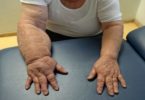What's in this article?
Breast Lumps Overview
A breast lump is a growth of tissue that develops within your breast. It may be described as a mass, growth, swelling, thickness or fullness.
A breast lump can vary in the way it looks and feels. If you have a breast lump, you may notice:
- A distinct lump with definite borders
- A thickened, slightly more prominent area in your breast that’s different from surrounding breast tissue
- Other breast changes, such as redness, dimpling or pitting of the skin
- One breast that’s noticeably larger than the other (breast asymmetry)
- Nipple changes, such as a nipple that’s pulled inward (nipple inversion) or spontaneous fluid discharge from your nipple
- Breast pain or tenderness
Sometimes, a breast lump is a sign of breast cancer. That’s why you should seek prompt medical evaluation. Fortunately, however, most breast lumps result from noncancerous (benign) conditions.
Common causes of breast lumps
Physiological (normal) swelling and tenderness
This is also known as fibrocystic change or fibroadenosis. Your breasts change throughout your menstrual cycle each month because of your hormones. At least half of all women who have periods will have some pain, tenderness and lumpiness in their breasts at some time in the month. This is usually most obvious in the week before your period. It quickly goes when your period starts. It is more common in women aged 30-50.
- Fibroadenoma. This is a benign (non-cancerous) breast lump that usually occurs in women under the age of 40. They occur as a result of excess growth of the glands and connective tissue in the breasts. They usually feel like round, firm, and rubbery lumps. They usually move slightly under the skin when they are pressed. They are not usually painful.
Sometimes they can disappear of their own accord or they can be removed. They tend to go after the menopause.
- Breast cysts. A cyst is a fluid-filled lump. Cysts are more common in women approaching menopause, although they can occur at any age. They are usually oval or round lumps that are smooth and firm. They tend to move slightly when pressed. It is common for them to appear within two weeks prior to your period and then resolve soon after the period.
Treatment of breast cysts typically involves draining the fluid in them by using a thin needle inserted into your breast by the doctor. After draining, about 3 in 10 cysts will refill with fluid, but can be drained again.
Breast lumps facts
- Breast lumps can be caused by infections, injuries, non-cancerous growths, and cancer.
- Breast cancer usually causes no pain in the breast. The symptoms of breast cancer include painless breast lumps, nipple discharge, and inflammation of the skin of the breast.
- The chances that a particular breast lump could be cancerous depends on many factors, including past medical history, physical examination, and genetic and other risk factors.
- The only way to be certain that a lump is not cancerous is to have a tissue sampling (biopsy). There are several ways to do the biopsy. The treatment of a breast lump depends on its cause.
How Your Breasts Should Feel
Breast tissue varies in consistency, with the upper-outer part of the breast being firm and the inner-lower parts feeling somewhat softer. If you are a woman, your breasts can become more tender or lumpy during your menstrual cycle. Breasts tend to get less dense as you get older.
It is important to be familiar with how your breasts normally feel so you are aware of changes. You should report any changes or concerns to your doctor.
Signs You Should See a Doctor
Remember, most breast lumps are non-cancerous. However, you should make an appointment to see your doctor if:
- you discover a new lump
- an area of your breast is noticeably different than the rest
- a lump does not go away after menstruation
- a lump changes or grows larger
- your breast is bruised for no apparent reason
- the skin of your breast is red or begins to pucker like an orange peel
- you have an inverted nipple (if it was not always inverted)
- you notice bloody discharge from the nipple
What are the symptoms of breast cancer?
The symptoms of breast cancer include painless breast lumps, nipple discharge, and inflammation of the skin of the breast. Sometimes breast cancer may not cause any symptoms.
Breast cancer usually causes no pain in the breast. Although women often worry about breast pain, most women with breast pain do not have breast cancer.
Nipple discharge that occurs without the nipple being touched can be caused by benign (non-cancerous) growths. Examples of these growths are intraductal papillomas (non-cancerous growths that protrude into the milk ducts) and dilated areas of milk ducts (ductal ectasia). Nipple discharge can also be caused by cancer of the breast tissue. Because nipple discharge can be a sign of cancer, it needs to be evaluated by a doctor.
Skin changes on the breast, including redness and warmth, can sometimes be a sign of breast cancer. A form of breast cancer that commonly causes these signs of inflammation is Paget’s disease of the breast. However, most inflammation or rashes on the breast are not due to cancer. They may be caused by benign problems such as nipple eczema or a fungus infection. Still, any breast rashes should be evaluated by a doctor. Areas that are especially scaly and red, particularly if they are persistent, or if there is also nipple discharge, are often sampled (biopsied) to rule out cancer.
Treatment for Breast Lumps
Your doctor must determine the cause of your breast lump before he or she can formulate a treatment plan. Not all breast lumps will need treatment.
If you have a breast infection, your doctor will probably prescribe antibiotics to cure it. If you have a cyst, it can be drained of fluids. Usually, cysts will go away after they’re drained.
If the lump is found to be breast cancer, treatment can include:
- lumpectomy (removal of the lump)
- mastectomy (removal of the breast)
- chemotherapy (the use of drugs to fight or destroy the cancer)
- radiation (the use of radioactive rays or materials to fight the cancer)
Your treatment will depend on the type of breast cancer you have, the size and location of the tumor, and whether the cancer has spread beyond your breast.





